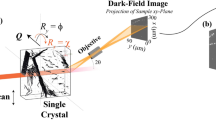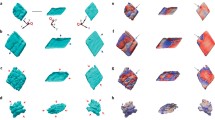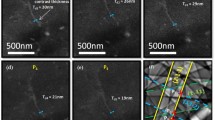Abstract
Weak-beam dark-field images of dislocations interacting with particles acquired over a large angular range were used to reconstruct tomograms, which were then used as the basis to construct a three-dimensional (3D) model of the dislocation structure. These capabilities facilitate viewing the dislocation structure from different directions, recovering the information lost in the electron beam direction. Coupling these capabilities and a method to include the specimen coordinate system within them with conventional dislocation analysis enables a full characterization of the dislocation microstructure in three dimensions. This approach is used to understand the 3D nature of the interaction of dislocations and a twist boundary with Al3Sc particles in an Al–Mg–Sc alloy.







Similar content being viewed by others
References
F.J. Humphreys and P.B. Hirsch: The deformation of single crystals of copper and copper-zinc alloys containing alumina particles. II. Microstructure and dislocation-particles interactions. Proc. R. Soc. London, A 318, 73 (1970).
B.G. Clark, I.M. Robertson, L.M. Dougherty, D.C. Ahn, and P. Sofronis: High-temperature dislocation-precipitate interactions in Al alloys: An in situ transmission electron microscopy deformation study. J. Mater. Res. 20, 1792 (2005).
L.M. Dougherty, I.M. Robertson, and J.S. Vetrano: Direct observation of the behavior of grain boundaries during continuous dynamic recrystallization in an Al-4Mg-0.3Sc alloy. Acta Mater. 51, 4367 (2003).
Y. Xiang, D.J. Srolovitz, L.T. Cheng, and E. Weinan: Level set simulations of dislocation-particle bypass mechanisms. Acta Mater. 52, 1745 (2004).
Y. Xiang, L.T. Chang, D.J. Srolovitz, and E. Weinan: A level set method for dislocation dynamics. Acta Mater. 51, 5499 (2003).
Y. Xiang and D.J. Srolovitz: Dislocation climb effects on particle bypass mechanisms. Philos. Mag. 86, 3937 (2006).
L.M. Dougherty: Ph.D. Thesis, University of Illinois at Urbana−Champaign, 2003.
B.G. Clark: Ph.D. Thesis, University of Illinois at Urbana−Champaign, 2006.
B.F. McEwen and M. Marko: The emergence of electron tomography as an important tool for investigating cellular ultrastructure. J. Histochem. Cytochem. 49, 553 (2001).
B.F. McEwen, C. Renken, M. Marko, C. Mannella, J.C. John, and I.W. Detrich: Principles and practice in electron tomography. Methods Cell Biol. 89, 129 (2008).
P.A. Midgley and R.E. Dunin-Borkowski: Electron tomography and holography in materials science. Nat. Mater. 8, 271 (2009).
J.H. Sharp, J.S.B.K. Kaneko, K. Higashida, and P.A. Midgley: Dislocation tomography made easy: A reconstruction from ADF STEM images obtained using automated image shift correction. J. Phys. Conf. Ser. 126, (2008).
J.S. Barnard, J. Sharp, J.R. Tong, and P.A. Midgley: Weak-beam dark-field electron tomography of dislocations in GaN. J. Phys. Conf. Ser. 26, 247 (2006).
M. Tanaka, K. Higashida, K. Kaneko, S. Hata, and M. Mitsuhara: Crack tip dislocations revealed by electron tomography in silicon single crystal. Scr. Mater. 59, 901 (2008).
M. Tanaka, M. Honda, M. Mitsuhara, S. Hata, K. Kaneko, and K. Higashida: Three-dimensional observation of dislocations by electron tomography in a silicon crystal. Mater. Trans. 49, 1953 (2008).
M. Tanaka, G.S. Liu, T. Kishida, H. Higashida, and I.M. Robertson: Transition from a punched-out dislocation to a slip dislocation revealed by electron tomography. J. Mater. Res. 25, 2292 (2010).
M. Tanaka, S. Sadamatsu, G.S. Liu, H. Nakamura, H. Higashida, and I.M. Robertson: Sequential multiplication of dislocation sources along a crack front revealed by HVEM-tomography. J. Mater. Res. (in press).
Acknowledgments
The electron microscopy was performed at the Center for Microanalysis of Materials in the Frederick Seitz Materials Research Laboratory, University of Illinois. EM3D was developed by the McMahan Lab, Stanford University School of Medicine, and Chimera by the Resource for Biocomputing, Visualization, and Informatics at the University of California, San Francisco. G.S. Liu is grateful to Mr. Thomas Goddard at UCSF for fruitful discussions and correspondence and Dr. Martha Briceno for provision of gold foils. This work was supported by the U.S. Department of Energy, Office of Basic Energy Sciences under contract DE-FG02-07ER46443.
Author information
Authors and Affiliations
Corresponding author
Rights and permissions
About this article
Cite this article
Liu, G., Robertson, I. Three-dimensional visualization of dislocation-precipitate interactions in a Al–4Mg–0.3Sc alloy using weak-beam dark-field electron tomography. Journal of Materials Research 26, 514–522 (2011). https://doi.org/10.1557/jmr.2010.83
Received:
Accepted:
Published:
Issue Date:
DOI: https://doi.org/10.1557/jmr.2010.83




